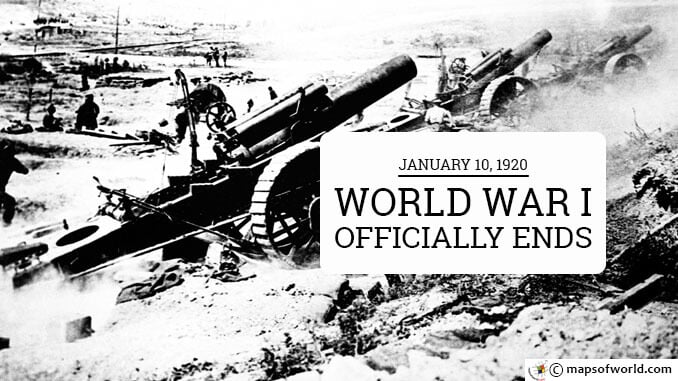On January 10, 1920, the Treaty of Versailles came into effect, thus officially ending the First World War or the Great War. The treaty had been signed between the Allied Powers (Great Britain, France, and Russia) and Germany earlier in June 1919 – five years after the assassination of Archduke Franz Ferdinand. Although fighting had ended with the signing of the Armistice on November 11, 1918, peace negotiations went on for over six months and the peace treaties including the Treaty of Versailles were an outcome of the Paris Peace Conference of 1919. The Treaty of Versailles was registered by the Secretariat of the League of Nations on October 21, 1919. World War I was waged between 1914 and 1918 by two opposing groups of nations or alliances – the Allied Powers and the Central Powers. Twenty-seven countries were named as the Allied and Associated Powers in the Treaty of Versailles. Considering, though, that the colonies of European nations also went to war, it may truly be called an armed global conflict – the first of its kind. Over 70 million military personnel were deployed and apart from the ruination of many economies, the war caused over 9 million causalities. War was a direct outcome of political rivalry and the arms race of European nations, precipitated by the assassination of Archduke Franz Ferdinand, heir apparent to the throne of Austria-Hungary. The declaration of war on Serbia by Austria-Hungary soon escalated to a global scale with France, Britain and Russia siding against Austria-Hungary, Germany, Bulgaria and the Ottoman Empire. The United States had initially declared neutrality in 1914 but in 1917, the US entered the war on the side of the Allied nations. A number of nations also joined in, resulting in an escalation in the scale of warfare. In 1918, after about 4 years of terrible warfare, Germany laid down arms and conceded defeat. Delegates of 27 Allied nations participated in the peace negotiations. US President Wilson became the first United States President to travel to Europe while in office, as he crossed the Atlantic to participate in the negotiations of the Treaty of Versailles. On June 28, 1919, the treaty was signed stripping Germany of nearly 25,000 square miles of territory and 7,000,000 people. The Treaty of Versailles was signed in the Hall of Mirrors of the Château de Versailles in the Île-de-France region, about 20 kilometers from Paris. The château was the site of the Paris Peace Conference. One of the most controversial provisions of the Treaty of Versailles was the imposition of all responsibility of the World War I damages on Germany. Germany was forced to acknowledge all liability for the losses and damages and was required to disarm and pay reparations of 132 billion Marks (considered the equivalent of USD 442 billion as of 2013). The treaty became the cause for much dissent in Europe. The German economy suffered badly due to the strain of the reparations. “This is not peace. It is an armistice for 20 years” said French Marshall Ferdinand Foch, Supreme Allied Commander about the Treaty of Versailles. The animosity sown by the treaty facilitated the growth of Adolf Hitler and the Nazi Party and led to more strife, thus becoming partly responsible for World War II. Another major outcome of the Treaty of Versailles was the establishment of the League of Nations – an organization meant to promote international peace and cooperation. The League of Nations was founded by the initiative of the Allies at the Paris Peace Conference of 1919. The Covenant of the League of Nations was drafted on June 25, 1919, as part of the Treaty of Versailles. President Woodrow Wilson sought the establishment of the League of Nations in his Fourteen Points, “A general association of nations must be formed under specific covenants for the purpose of affording mutual guarantees of political independence and territorial integrity to great and small states alike.” The US, however, did not join the league since the dissent of the Republicans did not permit the Treaty of Versailles to be ratified by the US Congress. The league was ultimately ineffective in bringing about global harmony and in preventing a subsequent world war, and had to be dissolved. You may also like : January 10 49 BCE – Julius Caesar Crosses the Rubicon
January 10 1920 – World War I Officially Ends As The Treaty Of Versailles Takes Effect
On January 10, 1920, the Treaty of Versailles came into effect, thus officially ending the First World War or the Great War. The treaty had been signed between the Allied…
477
previous post
